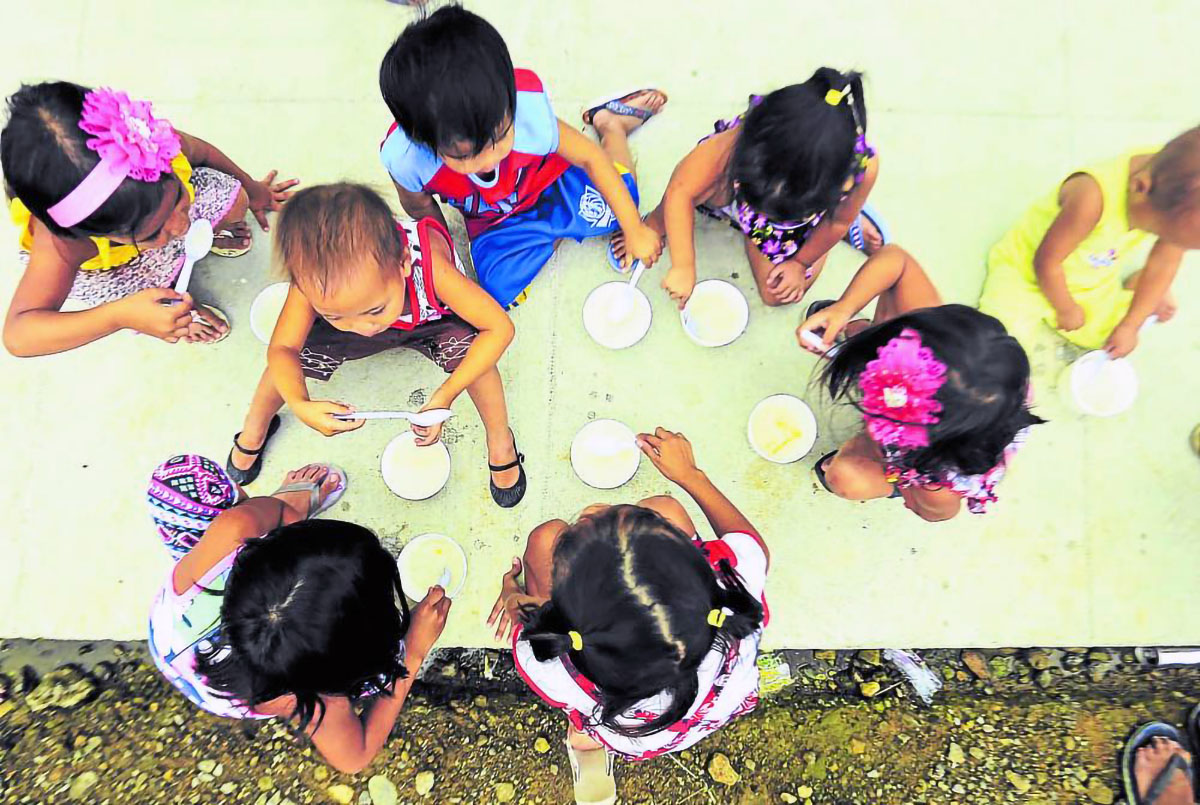Unicef: 2 million Filipino children severely food poor

MUCH NEEDED NOURISHMENT Despite high rates of child food poverty in the Philippines, Unicef has recognized government efforts to be more “nutrition-sensitive” in addressing malnourishment, as exemplified by this feeding program for children conducted by the local police in Sorsogon in March 2017. —MARK ALVIC ESPLANA
One in four children aged 5 and below around the world, including an estimated 2 million in the Philippines, are experiencing severe food poverty, according to a new study by the United Nations Children’s Fund (Unicef).
Released on Thursday, the 92-page report titled “Child Food Poverty: Nutrition Deprivation in Early Childhood” warned that these children would achieve less than optimal growth and development due to lack of access to a nutritious and diverse diet.
It was the first global report that analyzed the impacts and causes of dietary deprivation among the world’s youngest people in nearly 100 countries and across income groups.
According to the report, 440 million children are food poor, of whom 181 million children, or 27 percent, are severe cases.
Child food poverty is measured according to the dietary diversity scores of Unicef and the World Health Organization.
Article continues after this advertisementTo meet the minimum dietary diversity for healthy growth and development, children need to consume foods from at least five of eight defined food groups: breast milk; grains and roots; nuts and seeds; dairy products; flesh foods (meat, fish, and poultry); eggs; Vitamin A-rich fruits and vegetables; and other vegetables.
Article continues after this advertisementStunting, wasting
If children are fed only foods from two or fewer of these categories, they are considered to be in severe food poverty.
Four of five children in this situation are fed only breast milk or milk and/or a starchy staple, such as rice, corn, or wheat. Less than 10 percent of these children are fed fruits and vegetables, and less than 5 percent are fed nutrient-dense foods, such as eggs, fish, poultry, or meat.
READ: Study says most Filipinos can’t afford to eat healthy
Despite the government’s efforts to reduce stunting (low height for age) and wasting (low weight for age), the Philippines was counted among the 20 countries with the worst levels of child food poverty.
The other 19 are, in alphabetical order: Afghanistan, Bangladesh, China, Côte d’Ivoire, the Democratic Republic of the Congo, Egypt, Ethiopia, Ghana, India, Indonesia, Myanmar, the Niger, Nigeria, Pakistan, Somalia, South Africa, Uganda, the United Republic of Tanzania and Yemen.
According to the Unicef report, 18 percent, or around 2 million Filipino children age 5 and younger, are severely food-poor—higher than the 13 percent average among countries in East Asia and the Pacific region.
The report also noted that consumption of unhealthy food products was “particularly high” in the Philippines, where more than one in five children ate unhealthy food or drank sweet beverages.
“These unhealthy foods and sweet beverages are potentially displacing more nutritious foods from the diets of these young children,” it said.
Only rice, soup
In a statement, Unicef representative to the Philippines, Oyunsaikhan Dendevnorov, said: “Children living in severe food poverty are children living on the brink. This can have an irreversible negative impact on their survival, growth, and brain development.”
“Children who consume just rice and some vegetable soup a day are up to 50 percent more likely to experience severe forms of malnutrition,” he added.
Nevertheless, Unicef acknowledged the progress of the Philippine government’s 2023-2028 Plan of Action for Nutrition, which aims to increase consumer demand for healthy diets and improve access to adequate, age-appropriate, nutrient-dense, diverse, safe, and sustainable diets.
It also touted the efforts of the stewards of the Pantawid Pamilyang Pilipino Program to be “more nutrition-sensitive by targeting the most vulnerable families to help alleviate poverty and make quality food more affordable.”
Nearly half, or 46 percent, of all cases of severe child food poverty worldwide are among poor households, where income poverty is likely to be a major driver.
However, the report noted that a majority, or 54 percent, of severely food-poor children, lived in relatively wealthier households, where poor food environments and feeding practices were driving food poverty.
Factors fueling the crisis include food systems that fail to provide children with nutritious, safe, and accessible options, families’ inability to afford nutritious foods, and parents’ inability to adopt and sustain positive child-feeding practices.
In many places, cheap, nutrient-poor ultraprocessed foods and sugar-sweetened beverages are aggressively marketed to parents and families and are the new normal for feeding children. These unhealthy foods and beverages are consumed by an alarming proportion of young children, the report said.
Lifetime consequence
“Child food poverty harms all children, but it is particularly damaging in early childhood when insufficient dietary intake of essential nutrients can cause the greatest harm to child survival, physical growth, and cognitive development,” the report warned.
“The consequences can last a lifetime: children deprived of good nutrition in early childhood do less well at school and have lower earning capacity in adulthood, trapping them and their families in a cycle of poverty and deprivation,” it added.
The report warned that while countries were still recovering from the socioeconomic impacts of the COVID-19 pandemic, the effects of growing inequities, conflicts, and the climate crisis had pushed food prices and the cost of living to record-high levels.
To end child food poverty, Unicef called on governments, development and humanitarian organizations, donors, civil society, and the food and beverage industry to urgently transform food systems to make nutritious, diverse, and healthy foods accessible, affordable, and desirable to children.